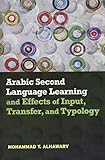Arabic Second Language Learning and Effects of Input, Transfer, and Typology
Material type: TextPublisher: Washington, DC: Georgetown University Press, 2019Description: xviii, 223 p., ill.; 23 cmISBN:
TextPublisher: Washington, DC: Georgetown University Press, 2019Description: xviii, 223 p., ill.; 23 cmISBN: - 9781626166479
| Item type | Current library | Call number | Status | Date due | Barcode | |
|---|---|---|---|---|---|---|
 Books
Books
|
Netherlands-Flemish Institute in Cairo (NVIC) Library Small Library - 0.06 | C 648 (Browse shelf(Opens below)) | Available | C 648 |
Includes bibliographical references (pages 203-216) and index.
Description of the target structures -- Preliminaries -- Gender agreement -- Tense/aspect -- Null subjects -- Summary -- Notes -- Methods -- Research questions -- Participants -- Typological pairings : participants' l1s and l2s -- Instructional input of the participants -- Data collection -- Summary -- Notes -- The acquisition of nominal gender agreement -- Typological pairings -- Previous findings -- Results -- Summary -- Note -- The acquisition of verbal gender agreement -- Typological pairings -- Previous findings -- Results -- Input frequency -- Summary -- Notes -- The acqusition of tense/aspect -- Typological pairings -- Previous findings -- Results -- Input frequency -- Summary -- Notes -- The acquisition of null subjects -- Typological pairings -- Previous findings -- Results -- Input frequency -- Summary -- Notes -- Theoretical implications -- Preliminaries -- L1 transfer and usage-based learning and typological effects -- L1 transfer and ug access accounts -- Null subjects: more on l1 transfer -- L2 or l1 transfer? -- L1 transfer and speech processing prerequisites -- Summary and areas of future research -- Notes -- Pedagogical and applied implications -- Acquisition tendencies of the target structures -- Contributing acquisition factors -- Subfields of arabic applied linguistics informed by arabic sla -- Summary and areas of future research.
In 2010, Alhawary published Arabic Second Language Acquisition of Morphosyntax, which provided empirical data on Arabic second language acquisition (SLA) strategies. This proposed book follows the volume, using data to delve into issues of input, transfer, and typology. Alhawary's book relies on Arabic as a second language (L2) data from speakers whose first languages (L1s) are Chinese and Russian and aims to answer the following questions: How do adult Arabic L2 learners come to know about the combinatorial properties of morphemes, words, phrases, and clauses? Do they develop L2 knowledge systematically or randomly? Can they acquire the same range of syntactic and morphological knowledge as native speakers and to what extent? What are the developmental stages or paths, if any, along which Arabic L2 learners progress? What is the role of the native language in learning Arabic a second language? To what extent can input exposure override or minimize the effect of the native language and at what proficiency level? What evidence do the present data provide on the role of a second language (on that of another) and posited claims about such a role? What are other factors that have a bearing on learning Arabic as a second language? Answers will help teachers of Arabic and linguists seeking to understand and develop better methods for teaching Arabic.
There are no comments on this title.
